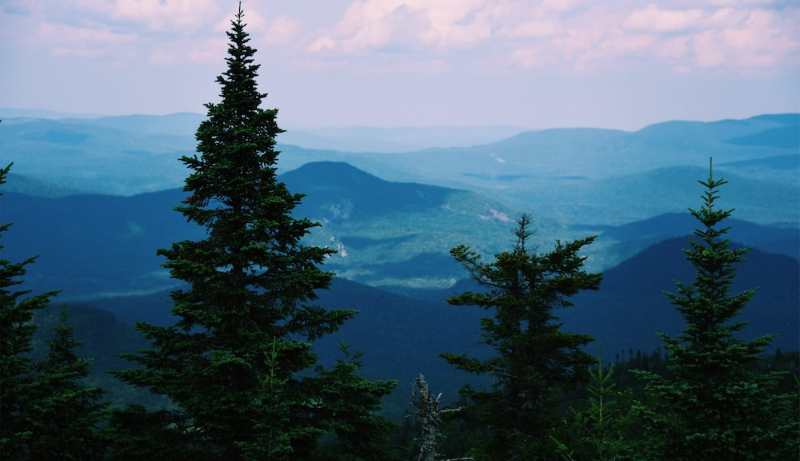Pine trees are prized additions to outdoor environments for a multitude of reasons. Whether you seek year-round bursts of green in snowy climes or simply adore that quintessential pine scent, there’s undoubtedly a pine tree that suits your preferences. These evergreen wonders span a spectrum, from petite varieties to colossal giants, with heights ranging from just a few feet to well over 100 feet.
But the life expectancy of a pine tree can vary depending on the specific species and its environmental conditions. In the right setting, with proper care and protection from diseases and pests, pine trees can thrive and endure for anywhere between 50 to over 450 years.
How Long Do Pine Trees Live?
Many homeowners turn to pine trees to add diversity to their gardens or landscapes, especially when seeking to break up the monotony of deciduous plants. Pine trees, with their evergreen foliage, inject vibrant green or golden hues into the winter’s snowy backdrop or the gloomy gray of inclement weather.
These versatile trees come in an array of shapes and sizes, offering you choices that align with your specific needs and preferences. The longevity of pine trees, however, varies depending on factors such as the tree’s species, local climate, and environmental influences.
In general, you can anticipate a robust and lengthy life for your pine tree, making it an enduring and cherished fixture in your garden or outdoor space.
Moreover, pine trees tend to be low-maintenance once they establish themselves and reach maturity. Ensuring the soil quality is rich and suitable prior to planting your young pine tree is essential. Initially, water it deeply and consistently until the roots take hold. As the tree matures, periodic feeding with appropriate fertilizer may be beneficial, although it is not always necessary.
With their longevity, adaptability, and minimal care requirements, pine trees prove to be not only aesthetically pleasing but also reliable and enduring companions in your outdoor oasis.
The Post-Cut Lifespan of Pine Trees
Pine trees hold a special place in our hearts, particularly as the quintessential Christmas tree. These evergreen treasures are felled, brought indoors, and adorned with tinsel, lights, ornaments, and popcorn strings to usher in the festive season.
In today’s world, some opt for artificial Christmas trees, storing and reusing them each holiday season, while others stay true to the traditional practice of procuring a live pine tree annually.
These living trees evoke cherished memories of visiting tree farms and the joy of bringing home a freshly cut tree. However, it’s essential to understand that once these real pine trees are severed from their root systems, they embark on a journey toward the conclusion of their lifespan. Much like freshly cut flowers in a vase, their longevity diminishes outside their natural habitat. So, how long can you expect a pine tree to thrive after being cut?
Typically, pine trees will remain vibrant for about 4-6 weeks following their cut, provided they receive sufficient hydration. Proper watering is crucial to prevent them from drying out, which can transform them into potential fire hazards, susceptible to ignition from open flames.

While some argue that using artificial trees is more environmentally friendly than cutting down live ones, it’s worth noting that purchasing a live tree from a local tree farm can also carry eco-friendly benefits. These trees are natural products that can find second lives as firewood, compost, or even decompose naturally, contributing to a sustainable and environmentally responsible cycle.
A Glimpse into the World of Pine Tree Diversity
Pine trees hold a cherished place in our hearts, often evoking images of Christmas, camping trips, hiking adventures, and the tranquil beauty of wooded landscapes. Despite their outward similarity, the pine tree family boasts a remarkable diversity, encompassing roughly 150 distinct species.
Here’s a glimpse into some of the most popular and renowned types of pine trees:
Eastern White Pine:
Native to the eastern regions of North America, the Eastern White Pine can live an impressive 100-200 years. In the wild, it can soar to towering heights of over 150 feet, with a sprawling canopy spanning 20-40 feet. Some exceptional specimens can even endure for up to 450 years, though the typical garden or yard lifespan is closer to 100 years.
Golden Pine Tree (Wate’s Golden):
This variety, known as the Golden Pine or Wate’s Golden, calls the Appalachian Mountain region home. It generally thrives for 60-90 years, reaching heights of 15-30 feet and spreading to about 20 feet at maturity.
Italian Pine Tree (Italian Stone Pine):
The Italian Pine, or Italian Stone Pine tree, typically enjoys a lifespan of 50-100 years. It reaches majestic heights of 40-80 feet upon maturity, a journey that spans 20-30 years. It’s frequently found in western regions like California and the Mediterranean.
Norfolk Island Pine Tree:
Originating from Australia and Norfolk Islands, the Norfolk Island Pine can achieve towering heights of up to 200 feet, bearing pine cones that can weigh up to a remarkable 15 pounds each. Surprisingly, this pine tree can also thrive as an indoor plant, typically topping out at 5-6 feet in height. In semi-tropical locales like Florida, these trees can flourish, provided they are planted in well-draining soil. With proper care, they can live for up to 150 years.
Lodgepole Pine:
One of the venerable giants of the pine tree family, the Lodgepole Pine can live an astonishing 400 years under favorable environmental conditions. It thrives in the Western United States, with its growth range extending from the Black Hills of South Dakota to Baja, California, and all the way to Yukon, Canada. Despite its remarkable lifespan, these pines typically reach heights of about 156 feet.
This diversity within the world of pine trees underscores their enduring popularity and their capacity to enrich our landscapes and outdoor experiences with their unique characteristics and aesthetics.
Determining the Age of a Pine Tree: Methods and Considerations
Whether you’ve recently moved into a new home and are curious about the age of the trees in your yard or you’re out hiking and encounter a towering pine tree that piques your interest, you might wonder how to gauge the age of a pine tree.
Several methods can help you estimate a pine tree’s age, each with its own advantages and limitations in terms of accuracy:
- Counting the Rings: The most precise method for determining a tree’s age involves counting the rings within its trunk. Each year of a tree’s life, it forms a new ring as the outer layer of the tree expands. However, this method necessitates cutting down the tree to access its trunk, making it impractical for most situations and environmentally unfriendly.
- Measuring Trunk Diameter: Another approach is to measure the diameter of the tree’s trunk. To do this accurately, you must identify the specific type of pine tree, as each variety has its own growth factor or rate. While this method provides an estimate of the tree’s age, it relies on certain assumptions and calculations. Measure the trunk’s circumference, divide it by the mathematical constant pi (approximately 3.14), and then multiply the result by the tree’s growth factor.
- Counting Whorls: Whorls are the rings of new branches that a tree produces each growth season. Counting these rings of branches is a simpler way to estimate a tree’s age without the need for complex calculations. However, it can be challenging, particularly if not all the whorls are visible.
It’s important to note that these methods offer estimates rather than precise ages. Additionally, some methods, like cutting down the tree to count rings, are not practical and should be avoided, especially for mature and healthy trees. Instead, opt for non-invasive methods like measuring trunk diameter or counting whorls when you’re curious about a pine tree’s age without harming it.
Comparing Pine Trees to Other Trees in Lifespan
When it comes to selecting trees to grace our yards, several factors come into play. We must consider a tree’s lifespan, how well it adapts to our region’s climate, and other environmental variables. Aesthetics also hold importance, particularly in breaking up the monotony of barren winter landscapes by planting evergreen trees like pine trees. So, how do pine trees stack up against other trees when it comes to lifespan?
Pine trees indeed have the potential for impressive longevity, with some individuals exceeding the millennium mark. However, both deciduous and evergreen trees can also boast remarkably long lifespans. In the context of backyard trees, the average lifespan of a pine tree typically falls within the range of 100-200 years, while deciduous trees in backyards tend to average around 80 years.

When making choices about which trees to plant in our yards, experts often emphasize the importance of strategic planning and proper placement to prevent potential issues with mature trees encroaching upon houses or structures. However, it’s worth considering that many people tend to reside in their homes for an average of only 13 years before moving on.
While functionality and safety are certainly significant factors to weigh, especially given the expense of removing mature trees for safety reasons, you may not need to fret excessively about the long-term aesthetics of your garden space in 30 years’ time. Ultimately, striking the right balance between practicality, beauty, and the trees’ lifespan can help create a harmonious and enduring landscape.
FAQ
1. How long does the average pine tree live in its natural environment?
In its natural habitat, the average lifespan of a pine tree typically ranges from 100 to 1,000 years, depending on the species and environmental conditions.
2. What is the typical lifespan of a pine tree in a backyard or garden setting?
Pine trees in backyard or garden settings often live between 100 and 200 years on average.
3. Can pine trees live for more than 1,000 years?
Yes, some pine tree species, such as the Great Basin bristlecone pine, have been known to live for over 4,000 years, making them some of the oldest living organisms on Earth.
4. Are there any pine tree species with shorter lifespans?
Yes, certain pine tree species have shorter lifespans, often averaging around 50 to 100 years. The lifespan can vary based on species and environmental factors.
5. What factors influence the lifespan of a pine tree?
Several factors can affect a pine tree’s lifespan, including environmental conditions, climate, soil quality, disease resistance, and human intervention.
6. Can proper care and maintenance extend the lifespan of a pine tree?
Yes, proper care and maintenance, including regular watering, fertilization, and protection against pests and diseases, can help extend the lifespan of a pine tree.
7. Do pine trees have a shorter lifespan when planted in urban areas?
Pine trees planted in urban areas may have a shorter lifespan due to factors such as pollution, limited space for root growth, and stress from urban conditions.
8. What is the primary cause of death for mature pine trees?
For mature pine trees, diseases and pests, such as bark beetles, can be significant contributors to their decline and eventual death.
9. Can pine trees live longer if they are regularly pruned and trimmed?
Regular pruning and trimming can help maintain a pine tree’s health and appearance, but excessive or improper pruning can potentially harm the tree, so it should be done with care.
10. Is it possible to estimate a pine tree’s age without cutting it down?
Yes, it is possible to estimate a pine tree’s age without cutting it down. Methods include measuring the trunk’s diameter, counting the whorls (ring-like structures of branches), and observing growth patterns, but these methods provide estimates rather than precise ages.
Final Word
Pine trees, with their enduring presence and contributions to our landscapes, continue to captivate our curiosity about their longevity. These remarkable trees, whether gracing our backyards, forests, or wilderness, can live for varying durations, ranging from a century to well over a millennium.
In their natural environments, they stand as sentinels of time, with some species enduring for thousands of years. However, in our cultivated gardens and urban spaces, their lifespans may be more modest, yet still impressive.
As we appreciate the beauty and benefits these trees offer, it’s essential to understand that their lifespans are influenced by numerous factors, including species, care, and environmental conditions. Proper care and stewardship can help extend their lives, ensuring that generations to come can enjoy the presence of these magnificent pine trees.
So, while we ponder the years that these trees have seen and the ones yet to come, let us continue to nurture and protect these natural wonders, ensuring they remain a vital part of our landscapes for generations to come.





Leave a Reply